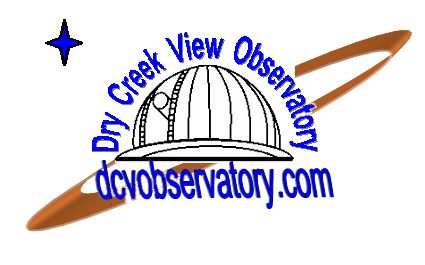Go
to Astronomical Viewing Blog Archive
Go To the Beginning Post
December 25, 2014
It has been two months since I last updated
my blog. First of all, I want to wish everyone a Merry Christmas
and hope all have a happy new year. Click on the image below
to view a short video of "He is the Gift" This
will direct you to YouTube.

I have been busy at the observatory, but
clear nights when I don't have work the next day have been
far and few between. Also, the Dry Creek View Observatory
has been published in an Electronic Magazine called Icy
Science. You can view the article by clicking
here "Dry Creek View article". The article
for the Dry Creek View Observatory begins on page 30. I
have also added a link in my "Friendly Links tab for
this magazine.
On November 24, I did have a clear night and
was able to take the following picture of the Pleaides cluster.
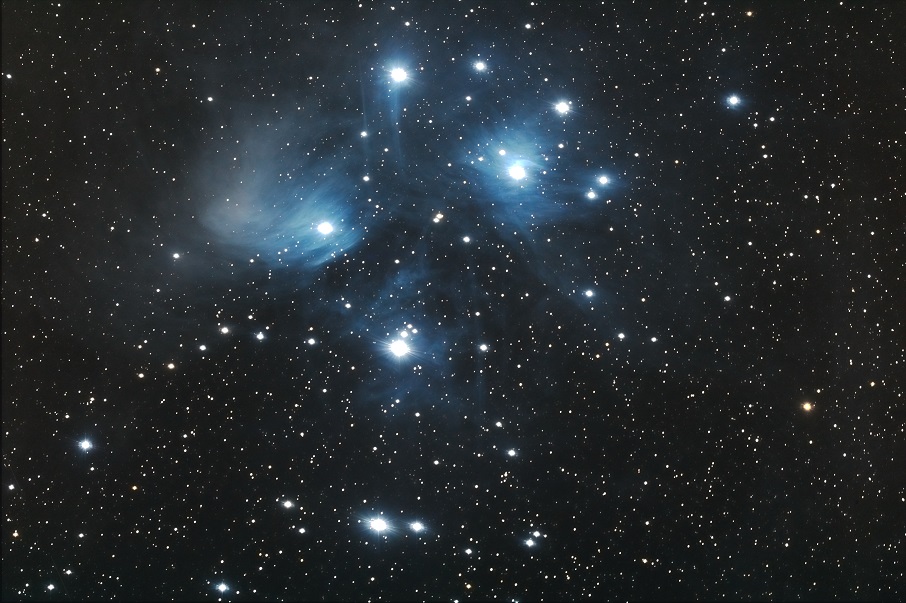
Pleaides Cluster
The above shot was taken with the Nikon D5200
Camera and the HyperStar Lens. I have also added larger
version of this picture to my gallery.
October 25, 2014
Thursday night into Friday was one of the
most beautiful nights for astrophotography this year. Not
a cloud in the sky, no moon and best of all I had the next
day off from work. I chose three different targets. The
first was IC 1396 or the Elephant Trunk Nebula. In that
batch, I took 10 shots for stacking at ISO 800 and a shutter
speed of 5 minutes using HyperStar at f1.9. I haven't stacked
these raw images yet, but will do so this week.
The next shot was the Orion Nebula M 42. This
shot I took 18 shots at one minute shutter and an ISO of
400. I also took 20 shots at ISO 400 with a shutter speed
of 1 second. This gives me good details of the trapezium
at the center of the nebula. The longer duration photos
came out great, and gives good details of the cloud structure
but the trapezium is completely blown out. I and going to
try my hand at layering in Photoshop. When I get the finished
product I will post it in my gallery.
To top off the night, I took this photo below:
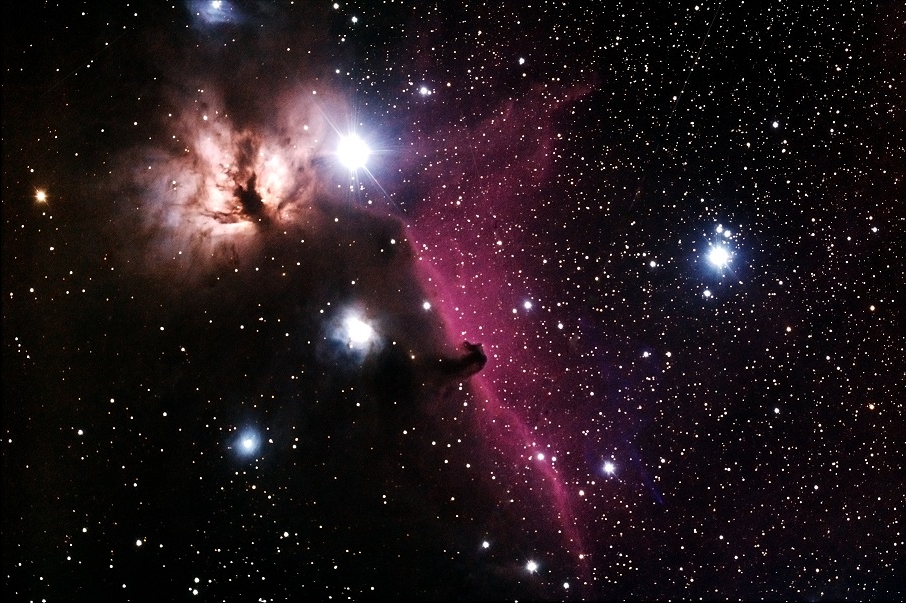
NGC 2024 Flame Nebula and IC 434 Horsehead
Nebula
The above is one of the most satisfying photos
that I have taken. Very little processing was needed. The
only problem was the satellites. Many of the individual
photos have streaks from passing satellites. The air brush
works in removing them, but I want a clean picture to mount
on my wall. I will definitely revisit this again. I truly
love my HyperStar lens. It make amateurs like myself look
good. A larger version can be seen in my Astrophotography
Gallery.
October 13, 2014
Lesson Learned: Last Wednesday
October 8, a group of young men and their leaders came to
the observatory and I learned a lesson about keeping my
scope "Go To Ready" I had not calibrated the "Go
To" function for about 6 months and when I was trying
to find objects it was a few degrees off and not even in
my eyepiece. I was able to find the objects, but I had to
search a bit. Just a word of advice for Celestron "Go
To" mount users, Calibrate your mount at least quarterly
(every 3 months) for best results. After the boys left,
I did a Two Star Alignment with 4 calibration stars. This
only took me about 10 minutes and the results were excellent.
Now everything is centered in the Eyepiece when I search
for an object.
Tonight is an extremely clear night. No clouds
and clear. Even though I need to go to work in the morning,
I just had to take advantage of such a clear night. I set
up some targets for taking pictures this weekend when I
have more time to spend and not worry about getting up.
I took a picture of the NGC 6946 galaxy to determine the
size and layout for my camera. I will try and get a clear
shot this Friday.
September 28,2014
"dcvobservatory.com" had
been hacked!!!! As I was checking out this web
site yesterday, I noticed that when anyone searched for
"Dry Creek View" in google, the search engine
found my site. Then when you clicked on the result, I was
surprised that it didn't take you to this site, but rater
to a "Beats Audio" site. I called "Godaddy"
my web hosting service and they found and corrected the
problem. Someone had hacked into my file manager on the
Godaddy account and redirected my web page. I don't know
why someone would want hack my site, but it happened. Just
a word of warning, make sure your passwords are secure!!!
September 24, 2014
I have been out of the country for the last
three weeks and have not been able to do any stargazing
or photography. I was visiting the great country of the
United Kingdom. I must say that the people there were the
most friendly people I have met. Everywhere we turned people
were courteous friendly and edger to give us directions
as we toured the country. The weather was beautiful for
touring, (no rain) but it was always cloudy so I couldn't
see the stars. tonight is my first full night back and the
skies are clear. Needless to say, I will be taking pictures
tonight. Before I left, I took a picture of the Iris Nebula.
I took this picture on August 30 just before we left for
the UK. A larger version can be seen in the Gallery.
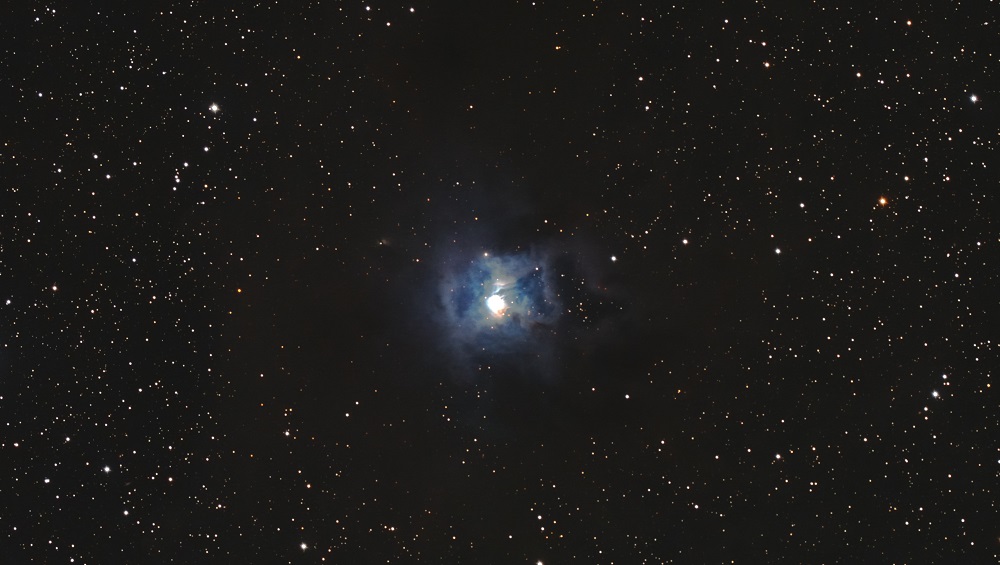
Iris Nebula NGC 7023
August 24, 2014
I had allot of fun this weekend playing with
my new HyperStar lens. Actually it was Thursday night that
was clear. Friday and Saturday had large thunder storms
that blocked the night sky. I wanted to put all of my tricks
for photography together and take a picture of M 101. I
was shooting for 20 light frames to be stacked, but only
managed 11. I also took 20 flat frames before the actual
photo session began. I took the flat frames just after sunset
in the area of the sky for M 101. Because my HyperStar was
attached, the focal ratio was f/1.9 making it a very "fast"
optical path. My focus was set to nearly what it would be
for the galaxy, although I could not see it as the sky was
still a light blue. To see the vignetting of the system,
I needed to take the pictures at a shutter speed of 1/4000.
The ISO for the flats was set to my imaging ISO I was planning
to use. Therefore, I took 20 flats at ISO 400 and 20 at
ISO 800. Below is a picture of one of the flats I used,
notice the darker areas around the edges which is the vignetting
of the system:

Flat frame for the Imaging session.
ISO 400, shutter 1/4000
After the sky darkened, I started taking my
light frames. I used a shutter speed of 5 minutes so I could
set the ISO at 400. I only managed 11 frames, but I believe
the results of stacking 11 light frames and 10 flat frames
(I only used 10 of the 20) turned out very well. I did not
take any dark frames as the camera long exposure noise reduction
feature makes them unnecessary. The final result after processing
is below, a larger view can be seen in the gallery:
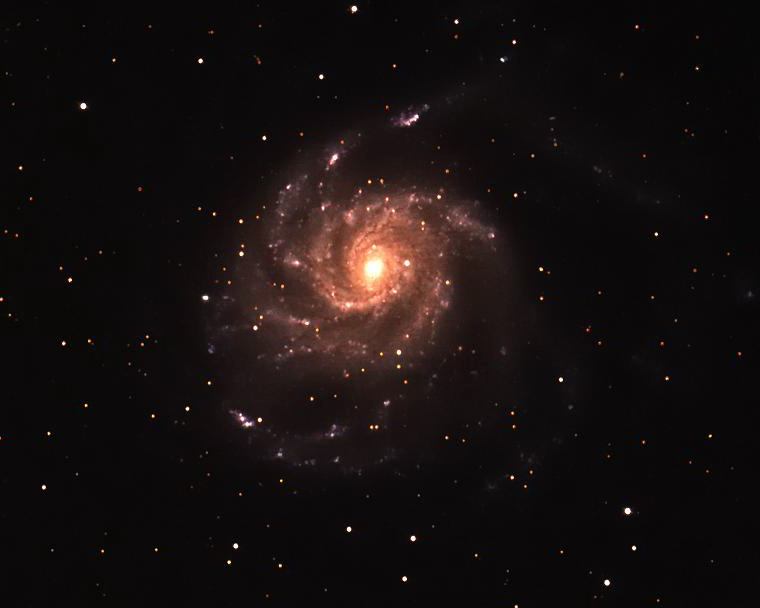
M 101 using HyperStar
August 17, 2014
The viewing conditions have been great this
weekend, and I have been able to truly test my HyperStar
lens. I have corrected my stacking problems with the help
of some other astronomers (Jeff Turner (DaltonSkyGazer)
and Paul) who know the DeepSkyStacker DSS program better
than I do. With the stacking problem behind me, I took 26
shots of M81 Bodes Nebula (Galaxy) using the HyperStar lens.
the results are below:
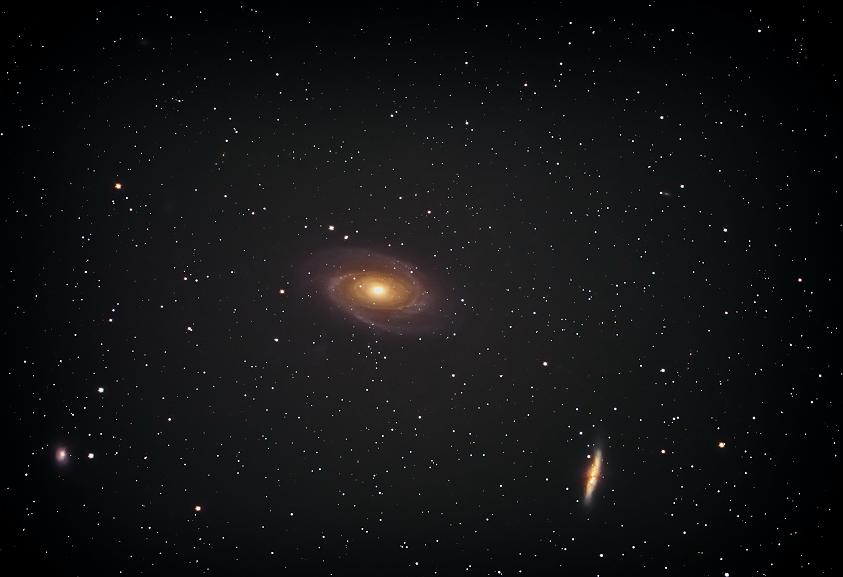
The above wide angle view shows M81, M82 NGC
3077. If you look closely in the gallery photo of this image
there is also a small galaxy in the upper 2nd quadrant.
M82 is pointing at it.
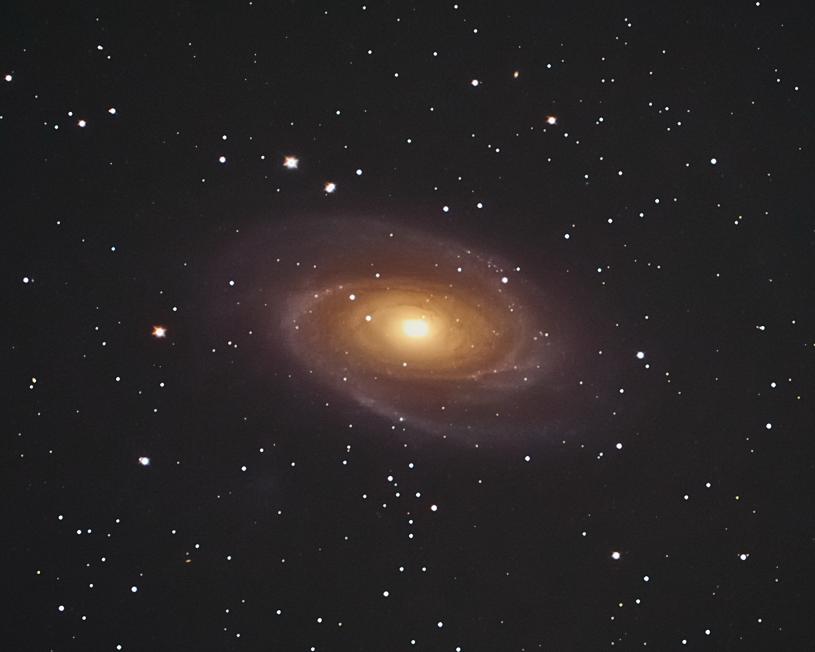
The above image is a cropped zoomed in image
of the wide angle photo above. I am pleased how it turned
out. It shows good detail from the resolution of the D5200
camera at 24 MP. Not quite as good it had been taken with
the full magnification without the hyperstar, but good enough
for a zoomed cropped image.
August 1, 2014
I finally got a chance to try out my new HyperStar
Lens. It was easy to attach to the scope and the reduction
in exposure time is awesome. I was able to take a 5 minute
shot of the Andromeda Galaxy at ISO 400!!!. This almost
completely eliminated any noise from the camera as the automatic
noise reduction in the camera seemed to give a clear picture.
Very little processing was needed. I only enhanced and balanced
the color. Another thing that was a joy to use was the "Micro
Touch" focuser. This device allowed me to focus from
my computer to get a crisp sharp picture. Below is the image.
I have also placed it in my gallery so you can see a bigger
image.
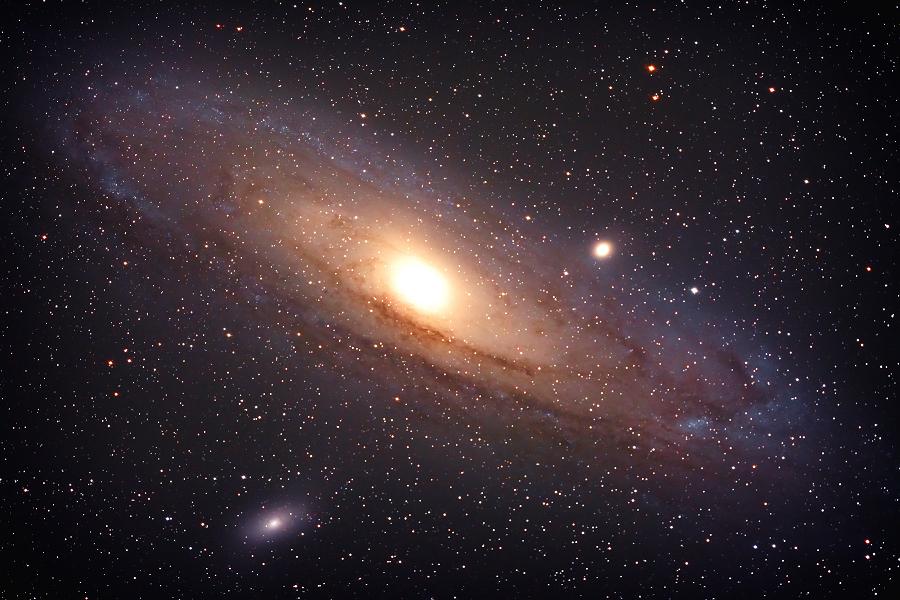
M31 Andromeda Galaxy taken with "HyperStar
Lens" attached to the CGE 1400
July 22, 2014
A lot has been happening at the Dry Creek
View Observatory. On Saturday July 12, the Robison family
came to the observatory to see Saturn, M 13, Mars and a
faint M 57. The moon was full and that was the final object
observed. It was bright and after viewing it, no other object
could be seen until the eyes readjusted. About 15 people
came to see the heavens.
As I said earlier, allot is happing here.
I purchased a Televue 55 mm Plossl eyepiece and a Televue
4X Powermate. I am gearing up to take some pictures of planets.
I also purchased a "HyperStar" lens so I can take
wide angle images through the scope. I even broke down an
purchased the Feather Touch autofocuser controller. When
I get everything setup, I will take pictures of each of
these accessories and give a write up on how they perform.
I hope my first images will be out by the end of the month.
July 3, 2014
I finally got a chance to post some of the pictures that
I took last November and January. I took them but did
not get a chance to process and post them. The first is
the Trianglumum Galaxy M 33. This shot was taken with
the D5200. Below is a comparason between the D3 camera
with an IR Filter and the D5200 Camera with no IR Filter.

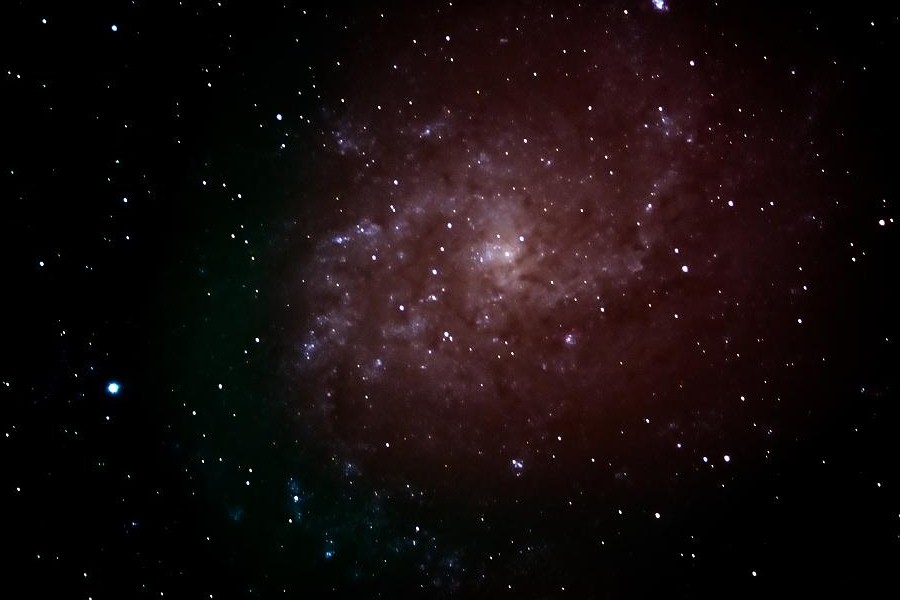
D3 Camera IR Filter _________D5200
Camera No IR Filter
I took an Earth Shine picture in January 2014. This shot
of the moon was when it was a very small crescent. I overexposed
the picture to get the effect of "Earth Shine".
The glow of the earth illuminates the moon instead of the
sun. It was a fun picture to take and is shown below.
Earth Shine
June 29, 2014
On June 12, a group of 9 young men came to see
the observatory. They were from Orem Utah about 80 miles north
of the Observatory. Since the moon was full, deep sky observing
was difficult. We were able to see Jupiter, Saturn, Ring Nebula,
and a globular cluster. The moon was the last object viewed
as it was full and bright.
On June 28, it was a very clear night. Everything
was available to be seen and photographed. I shot M 62 which
is shown below. A full size image can be seen in the Gallery.
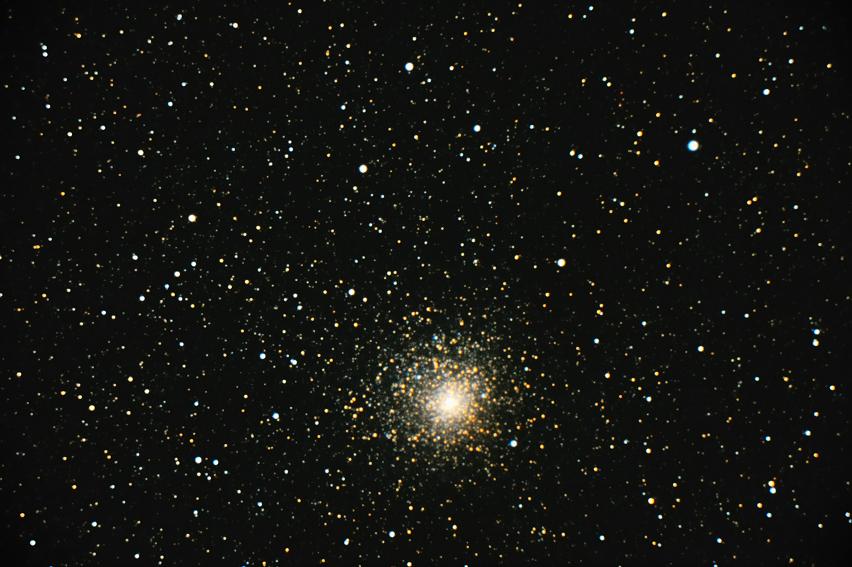
M 62
Camera Nikon D3, ISO 800, at 8 Minutes
June 2, 2014
Below is my first attempt at taking a picture
of a Comet. The target was C/2012 K1 (Panstars). It is presently
in the Big Dipper. Since I have to work for a living, I couldn't
stay up and take multiple shots and stack them. I took one
shot with the D3 camera and went to bed at 11:30 PM. My work
starts at 5:00 AM. But due to the moon rising, I only had
this one chance until next month. Below is my attempt. A full
size image can be seen in the Gallery.
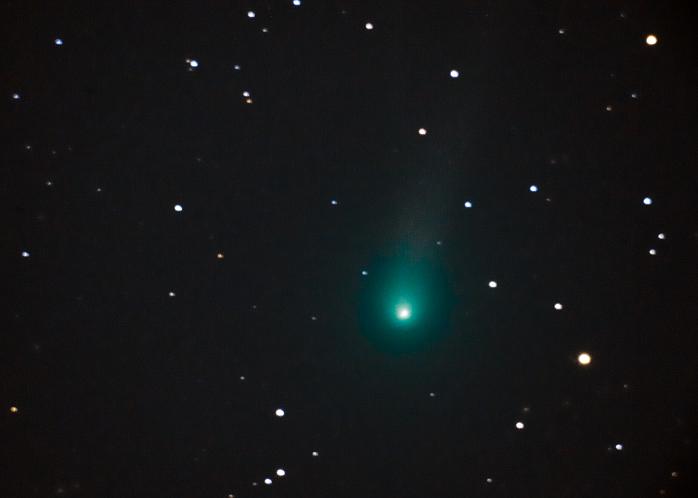
Comet C/2012 K1 (Panstars)
Camera Nikon D3, ISO 1600, at 6 Minutes
April 15, 2014
Even though it is a weeknight, I sacrificed sleep
and took the following pictures of the "Full Lunar Eclipse".


The image on the left 33% into
Eclipse. The image on the right is 90% into the Eclipse. Both
images were taken at ISO 200 and a shutter speed of 1/2500
sec.
The Full Eclipse
To get the detail and the color,
I needed to increase the exposure time. The full eclipse image
above was taken at ISO 200 and a shutter speed of 5 seconds.
Much slower than the 1/2500 second shots prior to the full eclipse.
April 10, 2014
Since my last blog update, I
have had a group of scouts, and a group of Young Women visit
the Observatory. With these groups we were able to see Jupiter,
the Orion Nebula, and the Andromeda Galaxy.
I also got my D5200 camera back
from the shop. This camera had a light leak which made it necessary
to crop out the entire left side of photographs that I had taken.
On April 5, I was able to take a photo of M51 the Whirlpool
Galaxy. Time was limited, so I was unable to take multiple photos
and stack them. The photo I took was taken at 2500 ISO for 7
minutes. I have found that the Nikon D3 has better noise reduction,
but with the IR filter removed from the Nikon D5200 I am able
to get much richer colors and in my opinion more natural colors.

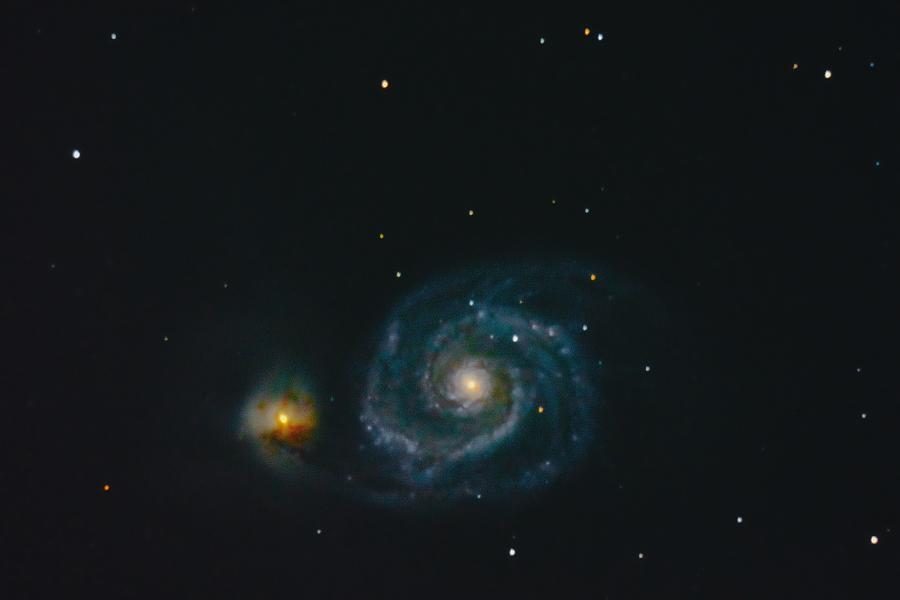
The image on the left was taken
with the D3 camera and the image on the right was taken with
the D5200. Because the D3 is a full frame camera, and the D5200
is a DX Crop camera, the image appears slightly larger with
the D5200. Both photos were taken at ISO 2500 and exposed for
7 minutes. Neither photo is stacked but is only a single image.
I really like how the colors turned out with the D5200. The
reason I purchased that camera is so I can remove the IR filter,
and it is physically smaller and therefore lighter. You can
see the comparison on my equipment page. When I get my FastStar
Lens, this will be my camera of choice due to its size. The
camera also has a higher resolution at 36 mp versus the D3 which
only has 12 mp.
January 1, 2014
Happy New year. I finally got
around to processing my picture of NGC 1977 taken on December
26. The picture was processed using the Nikon Capture NX2 Software.
I took 10 shots and stacked them using Deep Sky Stacker. The
results are shown below. A larger photo can be seen in the Gallery

NGC 1977 Running Man in the Constallaiton Orion
|
